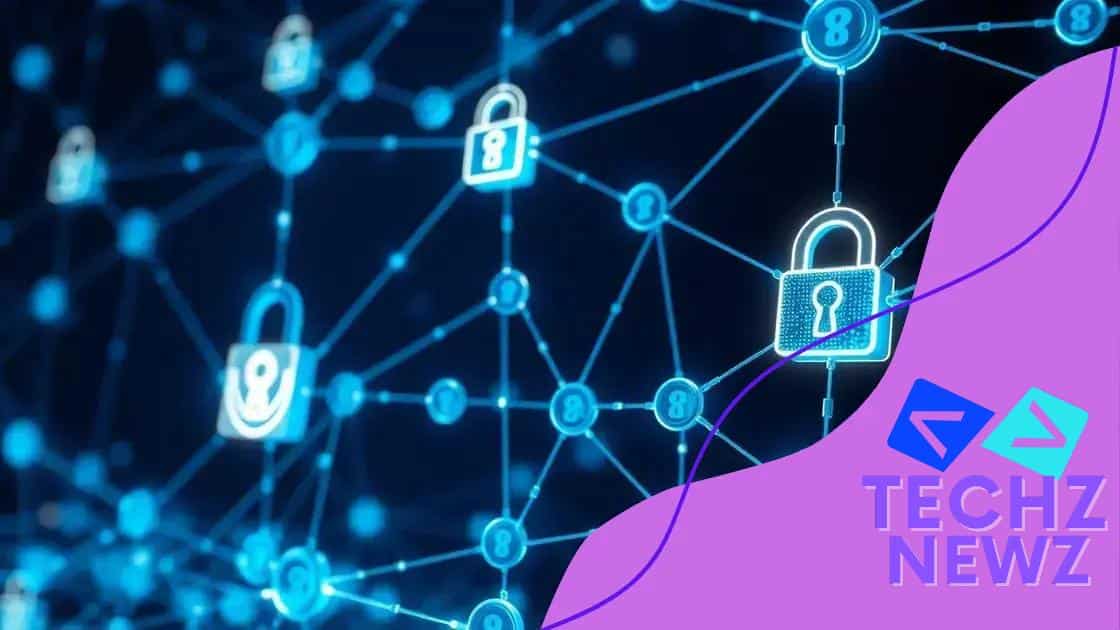Blockchain for managing digital copyrights effectively

Blockchain for managing digital copyrights enhances security, transparency, and efficiency, enabling creators to protect their works, streamline royalty processes, and ensure fair compensation while facing challenges like scalability and regulatory issues.
Blockchain for managing digital copyrights has emerged as a game-changer in protecting intellectual property. Have you ever wondered how this technology could reshape the landscape of ownership rights? This article uncovers its potential.
Understanding blockchain technology
Understanding blockchain technology is essential for anyone interested in how digital copyrights are managed today. This revolutionary technology offers a secure way to store and transfer data, ensuring that ownership and updates are easily tracked.
At its core, blockchain is a decentralized ledger that records transactions across many computers. It allows for information to be shared transparently while maintaining privacy, ensuring that content creators can protect their work effectively.
Key Features of Blockchain
Blockchain’s features make it an attractive option for managing digital copyrights. Here are a few that stand out:
- Decentralization: No single entity controls the blockchain, reducing the risk of fraud.
- Transparency: All transactions are visible on the network, which enhances trust among users.
- Immutability: Once a transaction is recorded, it cannot be altered, ensuring authenticity.
These characteristics not only strengthen copyright protection but also streamline the process of copyright registration and enforcement. As creators, artists can use blockchain to demonstrate ownership and avoid plagiarism, which has become increasingly important in the digital age.
Applications in Copyright Management
Various industries are harnessing blockchain technology to improve copyright management. Musicians, for instance, can use blockchain to track the distribution of their music. By doing so, they can ensure that they are compensated for every listen and prevent unauthorized usage.
Similarly, authors can issue digital tokens representing their work, granting access rights while retaining control over distribution. This innovative approach empowers creators and supports fair compensation across all digital platforms.
As the digital landscape continues to evolve, understanding blockchain’s role becomes crucial for anyone involved in content creation or copyright management. Embracing this technology will help safeguard intellectual property in an increasingly complex digital environment.
Benefits of blockchain in copyright management
Benefits of blockchain in copyright management are transformative for content creators and businesses alike. This technology offers enhanced security and efficiency, allowing better control over digital assets.
One of the main advantages is the protection of intellectual property. With blockchain, every transaction is timestamped and recorded, providing undeniable proof of ownership. This makes it much harder for unauthorized parties to misuse creative works.
Enhanced Security and Transparency
Blockchain’s structure provides a level of security that traditional systems can’t match. By using a decentralized network, it ensures that data cannot be easily altered. As a result, the risk of copyright infringement decreases significantly.
- Immutable records: Once data is entered, it cannot be removed or changed.
- Real-time monitoring: Creators can track how their work is being used across the internet.
- Proof of ownership: Establishing ownership is straightforward, minimizing disputes.
These features foster a trustworthy environment for artists and creators. In addition to security, blockchain simplifies licensing processes. Smart contracts can automate payments to creators based on usage, ensuring fair compensation without intermediaries.
Streamlined Processes
This automation reduces delays and misunderstandings in royalty payments. It cuts out the middleman, making transactions faster and more reliable. By streamlining processes, creators can focus more on their work and less on administrative burdens.
Moreover, it enhances collaboration among artists. As multiple parties can have access to the same validated records, sharing rights becomes easier. This collaborative approach enriches creative projects and opens new avenues for partnerships.
How blockchain ensures copyright security

How blockchain ensures copyright security is vital for protecting creative works in the digital era. This technology provides mechanisms that greatly enhance the safety of intellectual property.
One of the key components of blockchain is its decentralization. Unlike traditional databases controlled by a single entity, a blockchain is distributed across many computers. This means that no single point of failure exists; if one part of the network is compromised, the rest remain unaffected.
Immutable Records
Transactions on a blockchain are recorded in a way that makes them immutable. Once a transaction is added to the blockchain, it cannot be changed or deleted. This prevents unauthorized modifications and ensures that the original ownership of a piece remains intact.
- Timestamping: Every transaction is time-stamped, creating a clear record of when a copyright was established.
- Verifiable history: Anyone can verify the history of ownership, reducing disputes over who owns what.
- Increased trust: The transparency of blockchain builds trust between creators and users.
This enhanced trust is crucial for artists who need to protect their creations while providing access to their work. The use of smart contracts also automates important processes. These contracts execute automatically when specific conditions are met, ensuring that copyright terms are honored without the need for intermediaries.
Real-Time Monitoring
Moreover, blockchain allows for real-time monitoring of copyright usage. Creators can see how their work is distributed and consumed. This visibility helps in identifying unauthorized uses quickly, so they can take action.
With these combined features, blockchain significantly strengthens copyright security. It provides a robust framework that not only deters piracy but also fosters a fair environment for creators to thrive.
Real-world applications of blockchain for copyrights
Real-world applications of blockchain for copyrights demonstrate how this technology is changing the landscape for creators in various industries. By leveraging blockchain, artists and authors can protect their works more effectively than ever.
In the music industry, musicians are using blockchain to manage their rights and royalties. For example, platforms like Myco can track music usage in real time, ensuring that artists receive payment whenever their songs are played. This system reduces the need for intermediaries and streamlines royalty collection.
Publishing and Literature
In publishing, authors are creating digital versions of their books on the blockchain. This not only allows for better control over sales and distribution but also provides a way to track who owns a copy of their work. By using smart contracts, authors can set automatic payments based on book sales, ensuring they are paid fairly.
- Fractional ownership: Multiple investors can buy shares of a book, promoting diverse funding sources.
- Transparency: Readers can see how many times a book has been sold and by whom.
- Reduced piracy: By making ownership clear and verifiable, unauthorized copies can be more easily identified.
Visual artists are also finding immense value in blockchain technology. With the rise of non-fungible tokens (NFTs), artists can sell their digital artwork in unique formats. Each NFT is verified on the blockchain, proving ownership and authenticity. This has opened up new revenue streams for artists while ensuring that their creations are protected.
Film and Television
In the film industry, blockchain is used to manage distribution rights and track viewer engagement. Producers can quickly see how films are performing across different markets. This data helps in making informed decisions about future projects and marketing strategies.
Overall, the real-world applications of blockchain for copyrights not only enhance protection but also empower creators. As this technology continues to evolve, it promises even greater flexibility and security for all in the creative industries.
Challenges and future of blockchain in copyright
Challenges and future of blockchain in copyright are significant topics to consider as this technology becomes more mainstream. Despite its advantages, blockchain faces hurdles in widespread adoption and effectiveness in copyright management.
One major challenge is the scalability of blockchain networks. As more users join, the system can become overloaded, leading to slower transaction times. This can be a barrier for real-time applications, especially in industries like music and film where immediate data updates are critical.
Regulatory and Legal Issues
Another challenge lies in the regulatory landscape. Different countries have varying laws regarding copyright and digital assets. This inconsistency can create confusion for creators who want to protect their work globally. Furthermore, many jurisdictions have yet to recognize blockchain as a legally enforceable means of proving ownership.
- Intellectual property laws: Adapting existing laws to accommodate blockchain is essential.
- Copyright infringement: Determining liability for unauthorized use of works on decentralized platforms can be complex.
- International regulations: Global standards for blockchain use in copyright need development.
The future of blockchain in copyright management looks promising, despite these challenges. As technology evolves, solutions are emerging. For instance, developers are working on enhancing scalability through improved protocols. Layer 2 solutions can help transactions process faster without sacrificing security.
Innovations and Adoption
Moreover, educational initiatives are underway to inform creators about blockchain’s benefits and how to use it effectively. Increased understanding will lead to greater adoption among artists and creators, allowing them to take advantage of the security and transparency that blockchain offers.
As the industry matures, collaborations between blockchain developers and traditional media companies may facilitate a more seamless integration of this technology. The potential for a fairer, more transparent system in copyright management is on the horizon, paving the way for broader acceptance and innovation.
In conclusion, blockchain technology presents an exciting opportunity for managing copyrights effectively. It offers strong security features, enhances transparency, and can streamline processes for creators. Despite the challenges, such as scalability and regulatory issues, the future looks bright. As technology advances and awareness increases, blockchain can revolutionize the way we protect and share creative works. Embracing this technology will empower artists and ensure they receive fair compensation for their efforts.
FAQ – Frequently Asked Questions about Blockchain for Managing Digital Copyrights
What is blockchain technology?
Blockchain is a decentralized digital ledger that securely records transactions across multiple computers.
How does blockchain enhance copyright security?
Blockchain offers immutable records and transparency, ensuring the protection of creative works and proof of ownership.
What are some challenges facing blockchain in copyright management?
Scalability, regulatory issues, and the need for global standards are key challenges that hinder widespread adoption.
What is the future of blockchain in managing copyrights?
The future looks promising with potential innovations, increased awareness, and greater collaboration between creators and technology providers.





